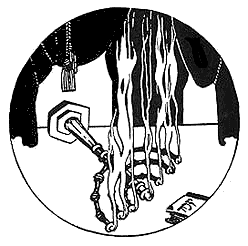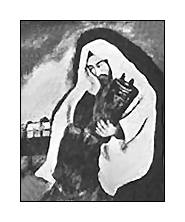
|
[Column 21]

Yitzchak Kacenelson
Translated from Yiddish by Judie Ostroff-Goldstein
Translation donated by Jane Prawda
| How can I sing – so that the world will know? How can I play with broken hands? Where are my dead? G-d, I am searching for my dead, In every hill of ash: - Oh, tell me, where are they?
Shout out from the sand, from under every stone,
Shout out from animal entrails in the forest, from fish in the river –
Oh, alas, my people appear. Raise your hands
Everybody come, from Treblinka, from Sobibor, from Ostrolenka, |
[Columns 23-24]
| Come, you who are drained, ground down, crushed. Come. Stand up, In a circle, a large circle around me, one large ring – Grandfathers, grandmothers, mothers with babies in their wombs – Come, Jewish babies of powder, of a bit of soap.
I am the man who watched, who saw
And now? You see wagons, trucks now, you watch,
The first killed were the children, forlorn, little orphans. They are called
They were the first to be taken to their deaths, the first ones on the wagon, |
[Columns 25-26]
| The sun will rise once more over small villages in Lithuania and Poland never to meet a Jew again A light in the dark, an old man, a man reciting a chapter of Psalms, a man going into the synagogue - After all, the peasants will travel in wagons on all the roads, they will travel to the fair after all, So many gentiles – good gracious! Yet more than before! And the market, the market is dead. The market is full and is not full!
There is no longer a Jew to beautify the fair for great distances around, they are no longer lively, there is no longer any spirit
And Jewish children – they will not wake up from sleeping, from dreams, every one of them bright in the morning –
They are gone already! Oh, on the other side of the ocean, do not ask, do not search in Kasrylewka, nor in Jehupiec…leave it alone! |
[Columns 27-28]
|
They will cry out to you from Bialik, speak to you from Scholem Aleichem, from Scholem Ash, from one of their books.
It is that lost voice from the Torah no longer heard from any yeshivas, from any study house and pale yeshiva students, |

Shimon Kanc
Translated from Yiddish by Judie Ostroff Goldstein
Only the first articles about one-time Czyzewo are an attempt to find the synthesis of the economic development process of the Jewish community in Czyzewo. In all the articles, which are in the part “Between The Two World Wars”, there is a tendency to analyze the facts and events. These are imparted as memories, warm and simple. It is important to mention the proficiency, in all cases, of the people who wrote articles. Examples of this are the works about the Jewish Community Council and about Tzentos (children's homes/orphanages) and the Merchant's Union. They bring out important scholarly problems that first had to be systematically and fundamentally elaborated.
The memories about the Zionist youth organizations are told with love and enthusiasm. They can be useful not only in studies of the shtetl, but also in studying the Zionist movement in Poland.
The part “Way of Life” and Folklore takes you further into the large feuds caused by the Hasidim and Mitnagdim (those opposed to Hassidism) shoykhet (ritual slaughterer) and the various institutions, types of people and images that created the flavor of the village.
The important entries are the eyewitness accounts by those who miraculously were survivors and who describe clearly everything that happened during the Holocaust in the Czyzewo ghetto.
From the ghetto material you can see that the Germans were in no small measure responsible for precipitating the annihilation of morality. People forced Jews into physical closeness, in order to intensify their spiritual distance. It is true there was a moral decline by those who worked on behalf of the Germans. But there was no stealing and looting, no scenes of Jewish cruelty,
[Columns 31-32]
of detachment from the suffering of brothers. There were also no cases of suicide.
There is an interesting description by I. Dawidowicz of the town today, almost twenty years after its destruction. “The screams of the murdered hang over the houses and people. The confusion that has been visited on the Poles is seen in all the misfortune that came to the town, the hand of justice and persecution for helping murder the Jews who truly built the town.”
One senses in the articles the reliability of the various people who brought out facts from oblivion.
The entire town was used as an important and valuable source of material. It serves the historian as a basis for research and scholarly synthesis and as a source to create material to illuminate our fundamental problems, but does not give any clear answers.
Despite the lack of analysis, these simple people created descriptions that give us a picture of life and death of the Jewish population in Czyzewo. The historian can learn about the way of life and the struggle led by the Czyzewo Jews to exist. Small articles, facts and figures give an idea about community activities that were of course led by parties (political) and organizations. The immense vitality, the great will to live and endure which existed even in the worst ghetto conditions will be found in these pages.
The characteristic common to all the articles, even the drier, documentary material, is the warmth with which they are written. This is the warmth of the Czyzewo Jew that he guards even in far off places.
[Columns 33-34]
(Hear, O Israel)
![czy0029.jpg [22 KB]](images/czy0029.jpg)
Take a look and see, there is such suffering here,
my suffering, that is my
burden. (Lamentations)
|
JewishGen, Inc. makes no representations regarding the accuracy of
the translation. The reader may wish to refer to the original material
for verification.
JewishGen is not responsible for inaccuracies or omissions in the original work and cannot rewrite or edit the text to correct inaccuracies and/or omissions.
Our mission is to produce a translation of the original work and we cannot verify the accuracy of statements or alter facts cited.
 Czyżew-Osada, Poland
Czyżew-Osada, Poland
 Yizkor Book Project
Yizkor Book Project
 JewishGen Home Page
JewishGen Home Page
Copyright © 1999-2024 by JewishGen, Inc.
Updated 2 Jul 2019 by LA